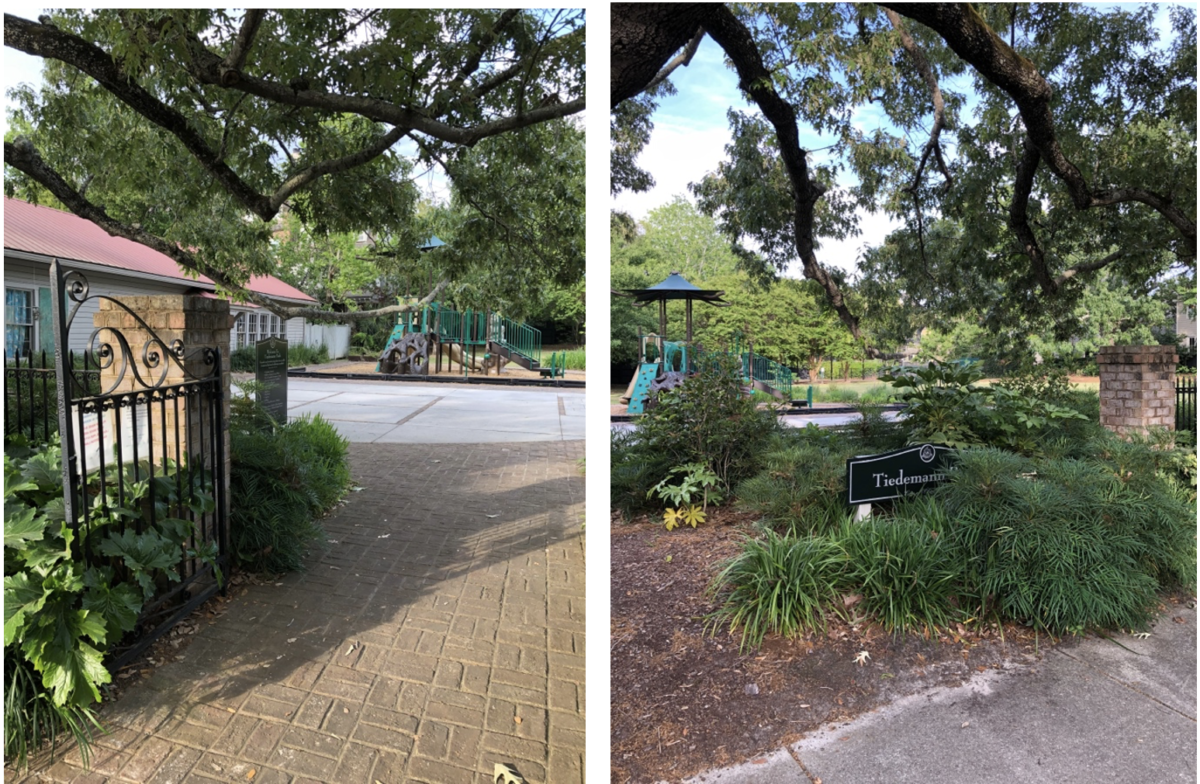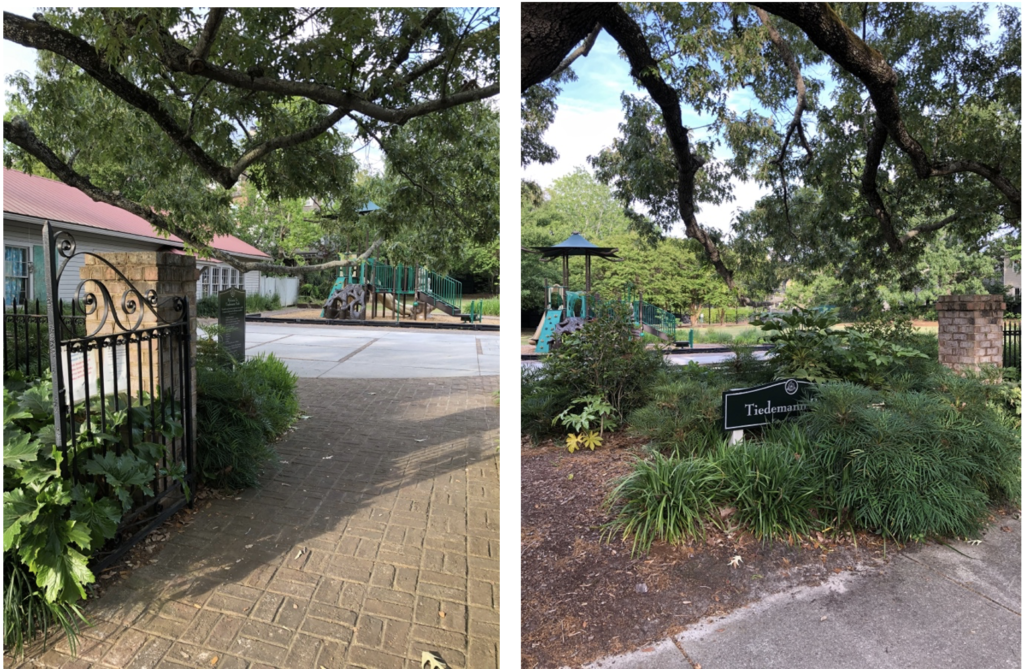Our historic city is full of greenspaces, but tourists usually miss Charleston’s hidden pocket parks. These beautiful small parks are tucked into quaint residential areas, making these green spaces feel more like private gardens than the lovingly maintained public amenities that they are. Charleston’s hidden pocket parks are true gems for the area residents.
Chapel Street Fountain Park is located on Elizabeth Street in quiet, treelined Wraggborough, a late eighteenth century suburban neighborhood. The pie shaped lot was underutilized in the past, situated between two lanes of Chapel Street, one of which had a large trainline that ran to the commercial wharves to the east. A park of sorts was in place by 1981 but was neglected, until Evangeline Rainsford, then president of the Wraggborough Neighborhood Association, started a campaign to renovate the space. She found the large fountain that serves as the focal point of the “Garden District” park behind the city horse stables at Hampton Park in a state of severe corrosion. She talked Mayor Riley into selling it, had it restored and placed in the triangular lot, which was rededicated as the park in 2003.
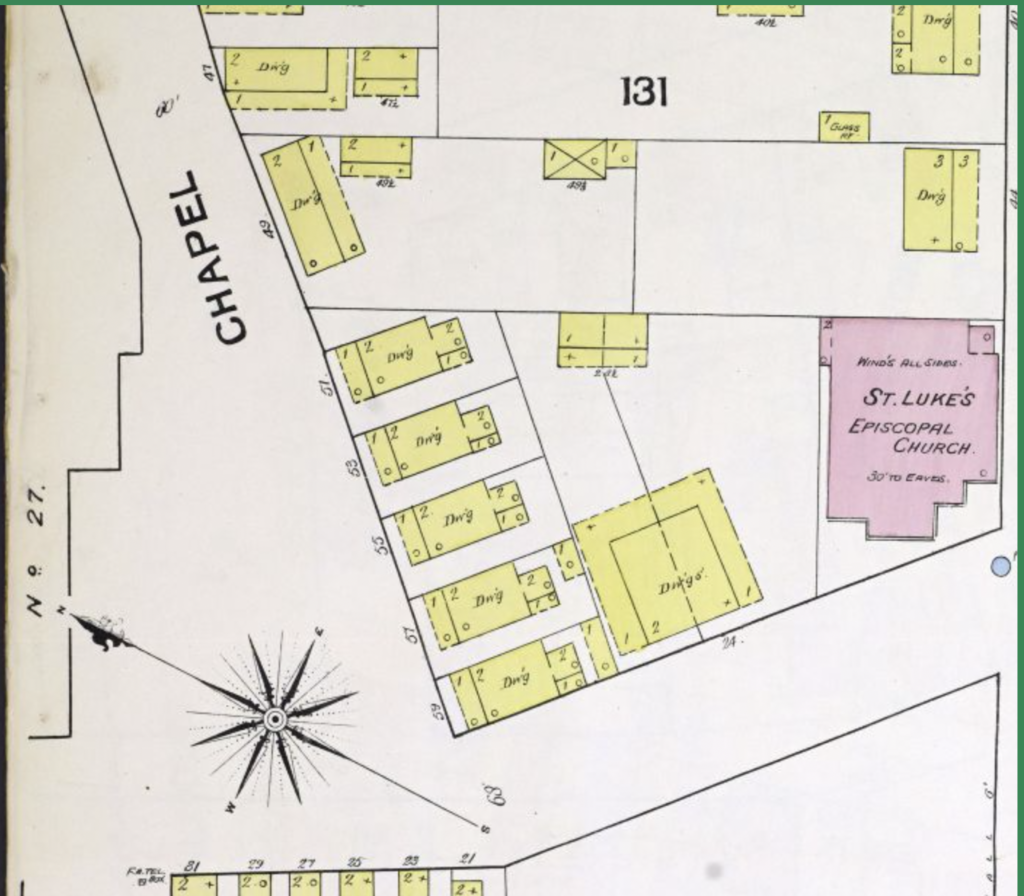
Chapel Street Park today is a live oak tree lined, pie shaped green space with secluded benches along Elizabeth Street, ornate plantings maintained by the Charleston Parks Conservancy, and the the beautiful historic cast iron fountain as its focal point.
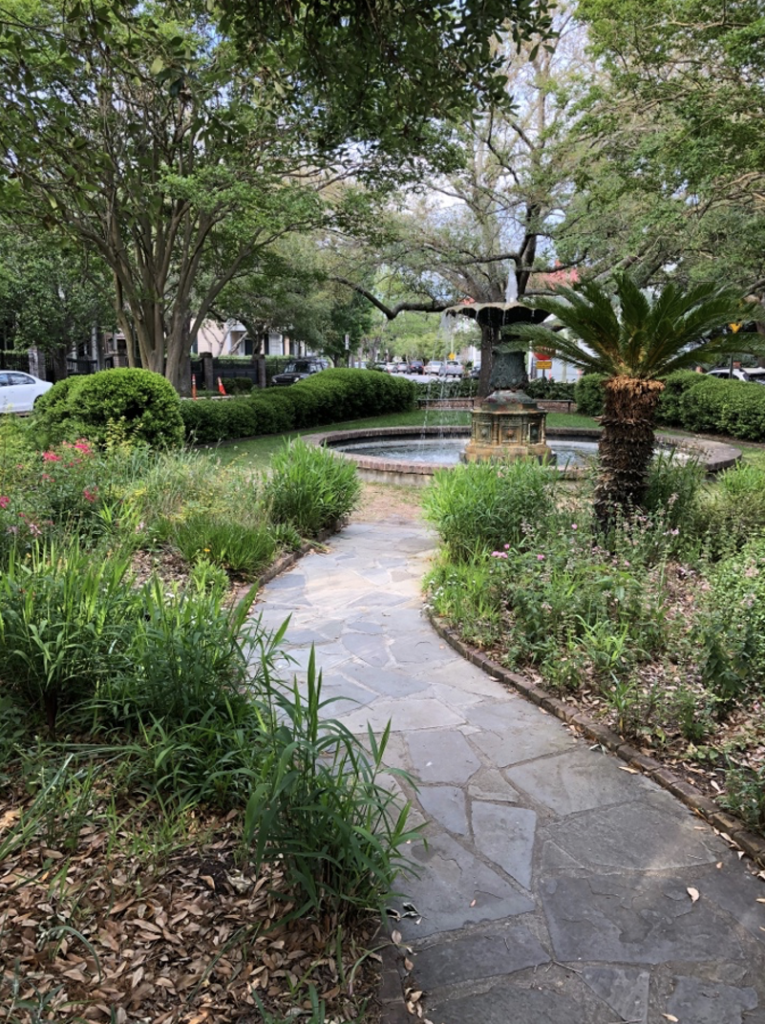
Just a block away on Elizabeth Street, the land that became Teidemann Park housed a large dray shed and dray stable (facilities for delivery horses and wagons), with a large grazing yard alongside the stable area, in the late nineteenth century.
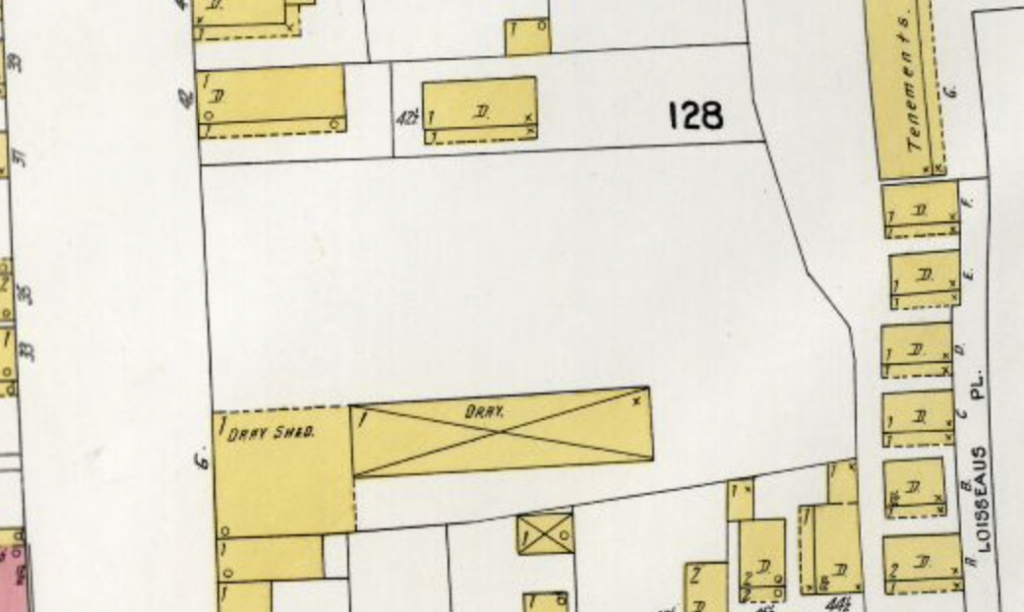
Those buildings were cleared and Tiedemann park opened in 1939. It is named for Elizabeth Klinck Tiedemann, a founding member of the city’s Playground Board (begun in 1910) and a kindergarten teacher. Tiedemann has a large lawn that is popular for impromptu sports and as a unofficial dog park, and it features a tennis and basketball court, a playground and swings, a planted bioswale, and a small Nature Center Building (where Tiedemann once offered free kindergarten classes), in which the city hosts summer camps and various activities for community children. The park was renovated and replanted by the Charleston Parks Conservancy in 2014.
Next up on Charleston’s hidden pocket parks lies East of Wraggborough in the Mazyckborough neighborhood at the foot of Charlotte Street: Irish Memorial Charlotte Street Park, one of the most unique and history-filled Charleston pocket parks. Sitting in the shadow of the modern State Ports Authority piers, the park site has a heritage as a maritime industrial landscape going back more than 200 years. William Smith channelized a tidal creek formerly on the site and built commercial wharves at the foot of Charlotte Street. By the 1890s, there were rail lines running next to the wharves and lumber mills on the edge of Mazyckorough.

The concept of creating a memorial dates back at least to the 1980s, and eventually Charlotte Street was selected as the location. The park was designed by noted landscape architect Sheila Wertimer and includes intricate brick hard scaping, flagstaffs for Charleston, the United States, and the Republic of Ireland, benches and plantings, a concrete and slate pier offering breathtaking views of the Cooper River and Ravenel Bridge, and a large, raised granite map of Ireland measuring 30 by 24 feet. The map shows the location of the various cities from which Charleston’s early Irish immigrants arrived- Ennis, Cork, Waterford, etc. Michael Collins, Irish Ambassador to the United States and several other dignitaries from the Republic of Ireland traveled to the city for the grand unveiling and dedication of the park in 2013. The $2.4 million park development, created by the City of Charleston, South Carolina Ancient Order of Hibernians, the James Hoban Society (which honors the Irish born designer of the White House, who spent time as an architect in antebellum Charleston), and the SC Irish Historical Society. It was funded in part with donations from Charleston’s Irish American community.
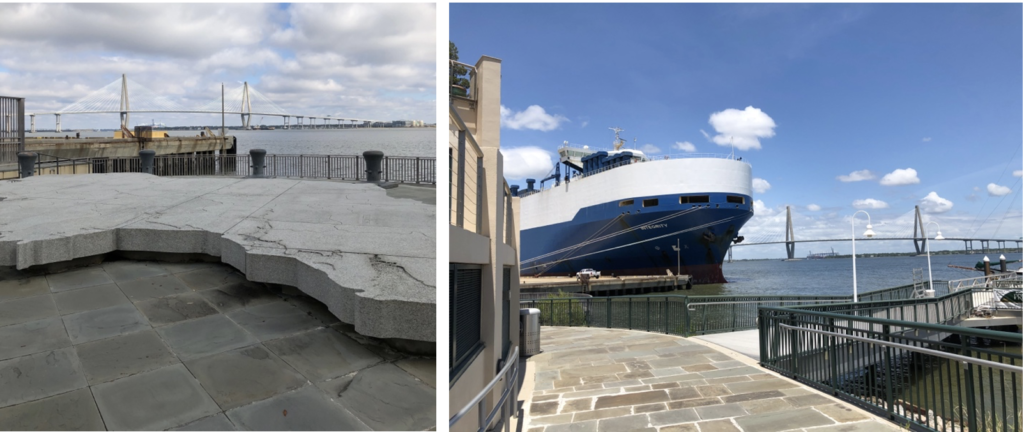
The newest Charleston pocket park is a few blocks southward in historic Ansonborough neighborhood. Theodora Park offers an outdoor living room for young professionals on lunch breaks, area residents, and visitors to the Gaillard Center and City of Charleston offices across the street. When Ansonborough was first laid out, George Street terminated at Anson Street and the Theodora Park site was a larger residential lot. Like Teidemann Park, this lot held a large wood frame stable building and wagon shed at the turn of the twentieth century, which was later torn down as the area ‘modernized.’

By the turn of the 21st century, there was small and potentially lovely but neglected park space on the lot, fully enclosed by a fence. Christina Butler notes in Ansonborough: Birth to Rebirth that, “In 2014, marketing and communications mogul, Ansonborough resident, and community steward David L. Rawle led the effort to transform the space into Theodora Park, a welcoming, tidy, and beautifully landscaped park and gathering place. Connecticut native Rawle grew up gardening with his mother (who served as an inspiration for the park) before moving to Charleston four decades ago, where “the gardens and parks seem especially luxurious to me, because the semi-tropical climate enables year-round beauty.” Charleston’s former Mayor Riley spearheaded a park renovation and new park building boom during his later terms, and Rawle became involved.” Rawle is quoted as saying, “My role in Charleston’s ‘park renaissance’ has been singularly focused on the creation of Theodora Park, a strategically located pocket park, which honors my mother [Theodora C. Rawle] and combines nature with art. Through a wonderfully successful public-private collaboration, we have been able to enrich Charleston’s already abundant park spaces.” Sheila Wertimer is also responsible for designing this fabulous park, which has seating, planting beds, a tree border to offer shade, a ornamental gate installation by nationally renowned ironworker Philip Simmons (1912-2009), and a 32 foot fountain pool bordered with handmade ceramic tiles by artist Paul Heroux.
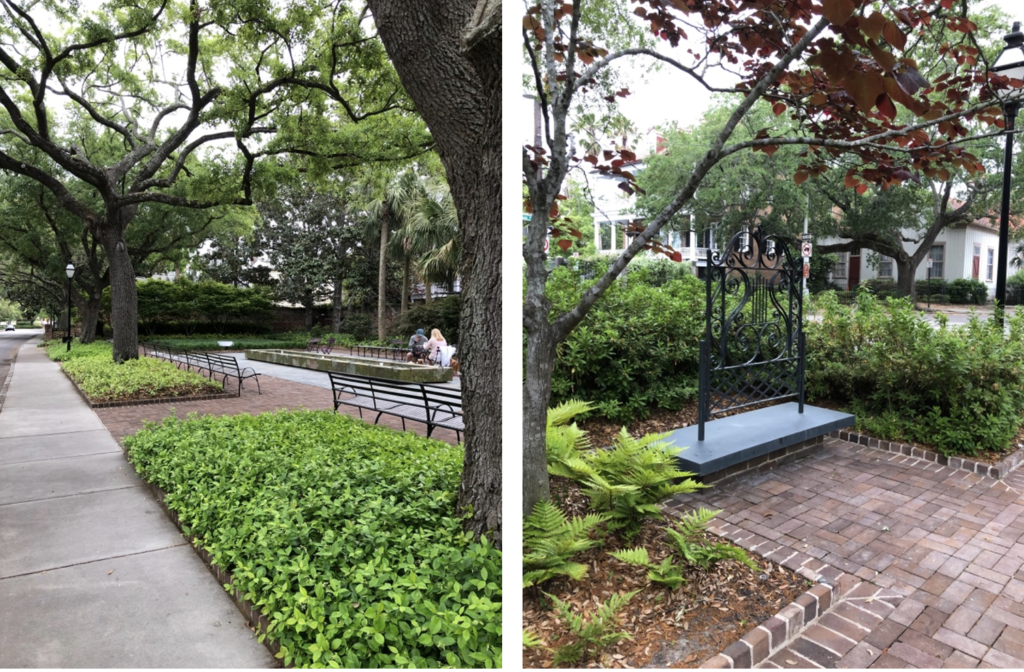
Sources:
- McCrady plat collection. Charleston County Deeds Office
- Sanborn Fire Insurance Maps
- Butler, Christina Rae. Lowcountry at High Tide: Flooding, Land Reclamation, and Drainage in Charleston, South Carolina. Columbia: University of South Carolina Press, 2020.
- Butler, Christina Rae. Ansonborough: From Birth to Rebirth. Blurb Books, for Historic Charleston Foundation, 2019.
- Robert Behre. “Tiny Theodora Park gets huge makeover”. Post and Courier. Charleston, South Carolina. 6 June 2015.
- http://www.theodorapark.com
- https://www.scaoh.org/charleston-irish-memorial/
- Schuyler Knopf. “Honoring the Irish: new park recognizes contributions ot SC history. Post and courier, 27 may 2013
- https://chstoday.6amcity.com/pocket-parks-in-charleston-sc/
- org (entries for Theodora, Chapel Street Fountain Parks.)
- “Free Kindergartens Close Next Week”. Charleston Evening Post. Charleston, South Carolina. December 15, 1943.
- Council Passes ’40 License Bill”. News and Courier. Charleston, South Carolina. November 29, 1939.
- “Enough Pie plans Pop-ups.” Post and Courier. 22 February 2014.
- “Chapel Street Fountain Park to be dedicated.” Post and Courier. 27 February 2003.

